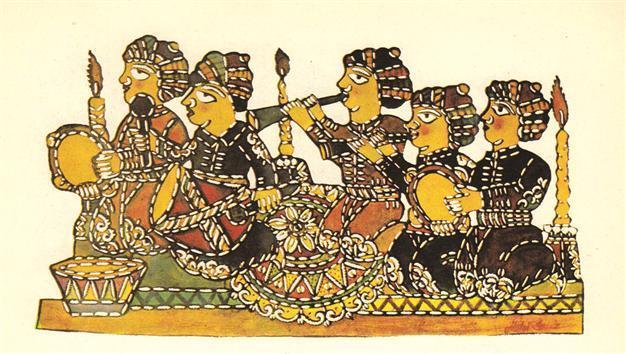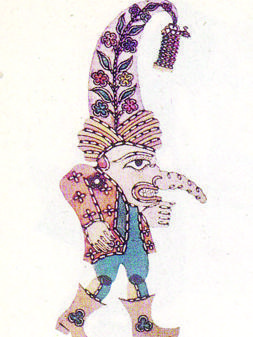Puppets, puppeteers and performances: Ottoman shadow theater
NIKI GAMM

A favorite pastime in the Ottoman era was watching the performances of Karagöz, the shadow theater.
To date, scholars have not been able to determine where this type of theater originated. Suggestions range from China and Java to Central Asia, and from India to Byzantine Greece. Some even mention the possibility that gypsies from northwest India may have brought the shadow theater west
Some Ottoman scholars have focused on Bursa during the reign of Sultan Beyazid I (r. 1389-1402) and believe that the two main characters, Hacivat and Karagöz, were real people who lived in that city at the time. The two men were construction workers who bickered with each other and joked to the amusement of their co-workers, resulting in delays in the completion of their construction work. So the sultan had them executed. Their antics were sorely missed, however, and the people of Bursa remembered and repeated them until they became ingrained in story-telling and puppetry.

Other researchers direct attention to Cairo, where the 17th-century travel writer Evliya Çelebi reported that Sultan Selim I saw a shadow play in 1517 after he conquered that city. Afterward he is supposed to have invited some of the actors to come to Istanbul to put on a performance for his son, Süleyman. So the real origins of the shadow theater, from this perspective, would most likely have been Java, where it spread west to India and then Egypt.
A look at the visual representation of Karagöz shows that he has a large eye with a black pupil, the origin of his name Karagöz, which means “black eye” in Turkish. His bald head is usually covered with a hat that can be knocked off suddenly to great waves of laughter, a long nose and a round black beard. He uses colloquial speech, is disrespectful of authority and often makes lewd and obscene remarks. Hacivat, on the other hand, has a pointed, turned-up beard and no other particularly distinguished marks. But he is a man of learning, who can recite poems and behaves as a man of the upper class world. The contrast between the two characters provides the audience with great amusement.
The theater includes three or four dozen other characters of greater or lesser importance, ranging from women, devils and prostitutes to policemen, Jews and European gentlemen. The women are often flighty in their behavior and are suspected of engaging in love affairs behind the backs of their husbands. A number of characters represent immigrants to Istanbul, such as a wood-cutter from Anatolia, a Laz man from the Black Sea who is employed as a boatman, someone from the Balkans who is either a wrestler or a carter, an Armenian major-domo and so on. The theater also features set pieces that represent buildings, such as lunatic asylums, hamams, fountains, gardens and even boats.
Plays and performancesMetin And, the late and great authority on the history of Turkish theater, described the shadow theater in his book on Karagöz as such:
“The main plot involves various types of people with different costumes, manners and dialects. Some of these plots have been handed down from generation to generation. Evliya Çelebi lists some of the play [sp.] which were in his day. However some puppeteers … tried to create new plots or vary the old ones by adding or subtracting characters or changing the order of appearance or title … The plots contain very little intrigue, action is only incidental. One important structural characteristic of these plots is that they are what we can call ‘open form’ or ‘flexible form.’ That is, each episode is an entity in itself and independent so that in each different performance, these episodes could change places, could be reduced, added to or subtracted from according to the audience’s reaction or the puppeteer’s wishes, without upsetting the general course.”
The performance consisted of three parts: first, a prologue or introduction; second, a dialogue and an interlude; and third, the main plot with a brief conclusion. This does not correspond to the ideals of western performance, in that each of the three sections is independent of the other and need not even incorporate the same subjects. The puppeteer was able to decide on which subject he would use either before the performance or possibly even during the performance. The most important goal, however, was getting the audience to laugh.
 Stages, puppets and puppeteers
Stages, puppets and puppeteersThe puppets in this shadow theater are flat and made from the skin of camels or other animals, which had been scrapped, oiled, dried and painted. The contours of the figures were cut out with the help of a mold; holes were punched in where the thread that held the puppet together could be inserted and knotted on both sides. Another hole was punched in the upper part of the puppet’s body, where the rod used to give motion to the puppet was inserted.
The stage was made of a white material, usually cotton, stretched on a frame approximately two by two-and-a-half meters, behind which an oil lantern was placed. This was done in such a way that hid the puppeteer’s hand’s shadow so it did not show on the screen, but the puppets, which were translucent, appeared highly colorful to the audience.
The puppeteer usually employed an assistant, who arranged all of the set-up prior to the performance. Depending on the number of puppets that would be used, there could be as many as four puppeteers performing at once. Each puppeteer had to be able to handle a range of voices and accents, depending on the puppets he was handling.
The assistant had to handle a crucial part of the performance, as And describes: “The difficulty in the shadow play technique is that the puppet master’s assistant must do almost everything himself, that is play the tambourine, sing songs, introduce each character and hand the puppets in the correct order to the puppet master. He also must hold motionless the characters on stage not involved in this particular action.”
There was also a fair amount of memorization involved, as shadow theater stories were handed down from one puppet master to the next. The master had to know 28 stories by heart, for example, one for each night during the month of Ramadan. Some of the scenarios were only written down in the 19th century. Often, texts could have been changed to reflect current events, in which the puppeteer had to spontaneously create a fitting repartee for both Hacivat and Karagöz.
Foreigners with sufficient knowledge of the land and who saw shadow theater performances said they were often astonished at how much the puppeteers could get away with in criticizing prominent people or the government of the day. Their freedom of speech was far beyond that of the West. That also went for situations in which sexual themes were discussed and acted out, even as respectable women and children were present in the audience. These puppeteers would not be able to get away with such freedom today.
 A favorite pastime in the Ottoman era was watching the performances of Karagöz, the shadow theater.
A favorite pastime in the Ottoman era was watching the performances of Karagöz, the shadow theater. Other researchers direct attention to Cairo, where the 17th-century travel writer Evliya Çelebi reported that Sultan Selim I saw a shadow play in 1517 after he conquered that city. Afterward he is supposed to have invited some of the actors to come to Istanbul to put on a performance for his son, Süleyman. So the real origins of the shadow theater, from this perspective, would most likely have been Java, where it spread west to India and then Egypt.
Other researchers direct attention to Cairo, where the 17th-century travel writer Evliya Çelebi reported that Sultan Selim I saw a shadow play in 1517 after he conquered that city. Afterward he is supposed to have invited some of the actors to come to Istanbul to put on a performance for his son, Süleyman. So the real origins of the shadow theater, from this perspective, would most likely have been Java, where it spread west to India and then Egypt.  Stages, puppets and puppeteers
Stages, puppets and puppeteers